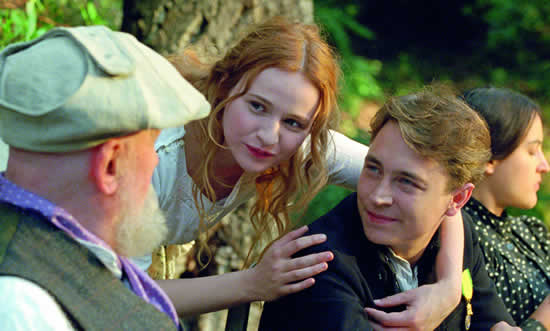 Gilles Bourdos’ “Renoir” is a vacation for the senses. Reminiscent of Bertrand Tavernier’s delicious “A Day In The Country” (his homage to Jean Renoir’s film) the film celebrates a late summer in the life of the ailing painter. Based on “Le Tableau amoureux” a bio-novel by the painter’s grandson cinematographer Jacques Renoir.
Gilles Bourdos’ “Renoir” is a vacation for the senses. Reminiscent of Bertrand Tavernier’s delicious “A Day In The Country” (his homage to Jean Renoir’s film) the film celebrates a late summer in the life of the ailing painter. Based on “Le Tableau amoureux” a bio-novel by the painter’s grandson cinematographer Jacques Renoir.
And what a step up for Gilles Bourdos. Working with cinematographer Ping Bin Lee (Ping Bin Lee “Millennium Mambo”, Wen Jiang’s brilliant 2007 “The Sun Also Rises”, ” Norwegian Wood”) Bourdos’ pastoral valentine to Renoir captures all the fruity palette of his later paintings, celebrated in last year’s traveling exposition “Late Renoir”
Mark Lee Ping Bin, who helped Hou Hsiao-Hsien capture Paris in his winsome “Flight of the Red Balloon” (2007), creates a ripe Impressionist summer for Bourdos.
Another collaborator, composer Alexandre Desplat, who like Ping Bin also worked on Bourdos’ “Afterwards” and “A Sight For Sore Eyes”, adds a musical energy to the seductive langour of the film
Looking exactly like Pierre Auguste Renoir in Sacha Guitry’s 1914-15 footage (“Ceux de Chez Nous”) Michel Bouquet (“Presidente Mitterande”) captures the determined painter. His hands crippled into a permanent claw, Renoir painted with a brush tied to his hand. Assistants, including his son Claude and the house of women who attended him after his wife Aline Charigot died, arranged his pallette, brushes and easel and carried him outdoors to paint plein air.
In 1913, two years before the setting of this film, 72-year-old Renoir stated “I’m starting to know how to paint…It has taken me over 50 years’ labor to get this far, and it’s not finished yet.” Seeking the variety of light, Renoir returned to plein-air painting and the inspiration of the old masters he had studied as a young painter.
Shot in the Riviera where Renoir had his last house (Les Collettes farm at Cagnes-sur-Mer), the langourous film portrays the life of two artists. Plot is jettisoned for ambience and an alluring ambiance it is.
A shot of glorious titian-haired Andree Heuschling (Christa Theret), biking along a country lane in her apricot outfit, is pure Renoir. The hopeful model, selected and sent by his late wife, is a stimulation Renoir cannot refuse. 15-year old Andree tries to make herself at home in the bantering circle of maids and cooks that make up Renoir’s henhouse. It’s a hard fit. The loyal women, many of whom modeled for Renoir in their younger days, resent her, and she won’t give them the satisfaction of obeying their orders.
Renoir, who was able to stand with difficulty, chose to reserve his energy and will power for his last paintings. His harem of women wheeled him out to the river, enabling Renoir to paint nudes posed al fresco. Youngest son, Claude (Coco)-(Thomas Doret-“The Kid With a Bike”) also attends his father. Older sons Pierre and are at the front.
Annoyed with teenager Claude, Renoir dotes on his second son Jean (Jean (Vincent Rottiers- “Les Diables”), who like his older brother Pierre, is fighting at the front
The film is also a coming–of–age piece for shy Jean, who’s proven himself with his Alpine Hunters 6th Battalion, but is unproven with women.
Salty Andree, whose rosy “skin soaks up light”, has developed her working relationship with Renoir père when Renoir fils arrives, wounded from the war.
Posing in the garden (where Jean first sees her) Andree typifies the voluptuous women glorified in Renoir’s “Les Beigneuses.” Renoir’s last mistress-model becomes Jean’s lover.
Plush Andree (later jean Renoir’s wife and first leading lady Catherine Hessling) is the final muse to the painter, and the first muse to his filmmaker son. A devotee of film magazines, Andree convinces convalescing Jean to become a filmmaker instead of returning to the Front.
Bourdos and scriptwriting partner Michel Spinosa include sly hints of the source of Renoir’s later film themes. Unlike Renoir père who pushed the horrors of war aside in his fervent painting, Jean Renoir wove that reality into his most iconic films.
A high collared officer, his face a map of battle burns, frequents the brothel where Jean finds rebellious Andree entertaining the troops. It’s an outtake from “Grand Illusion”. The hanging meat in Renoir’s kitchen recalls the kitchen in “Rules Of The Game”.
Mark Lee Ping-Bin’s interiors, shot with available window light, recall Vermeer’s compositions. Sun-dappled landscapes are the cinematographic equivalent of Impressionist lighting.

